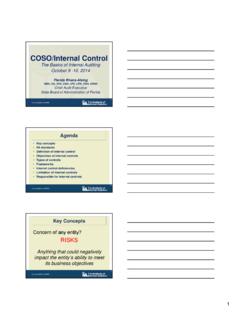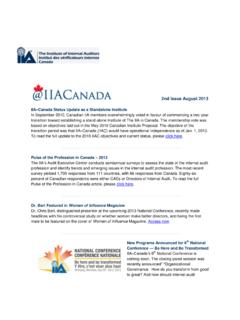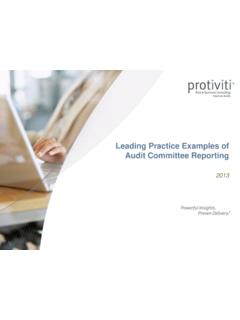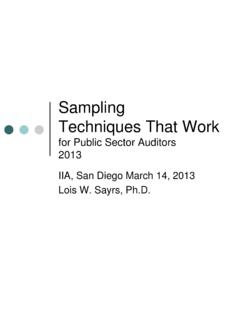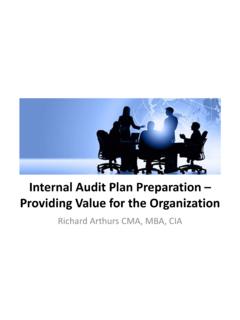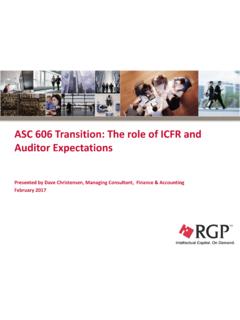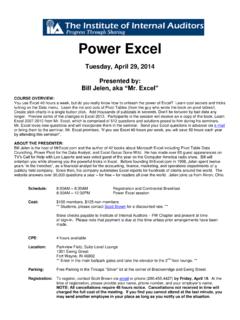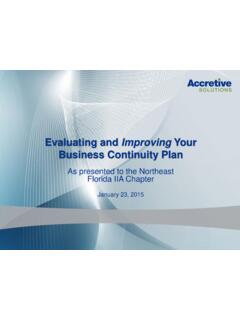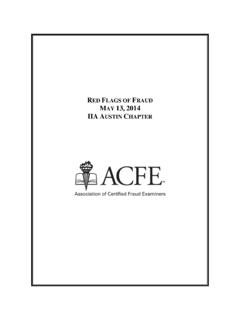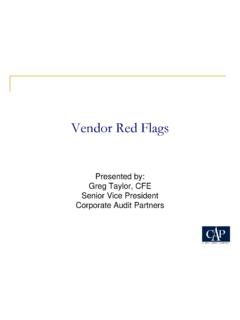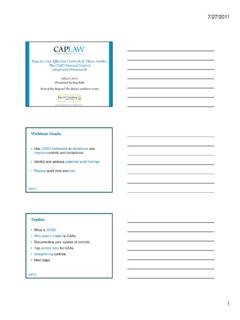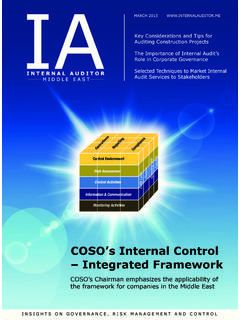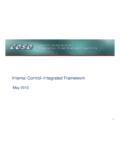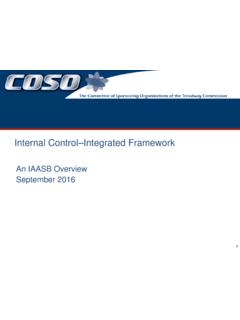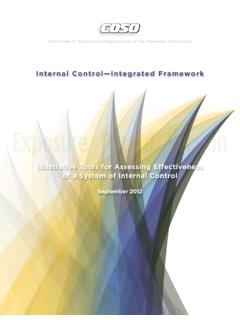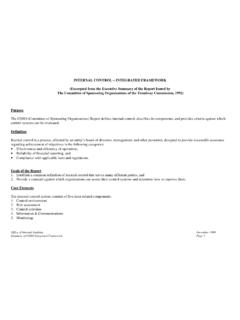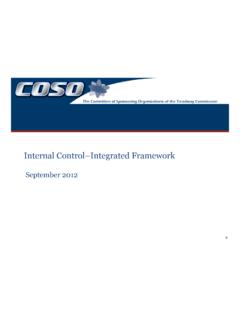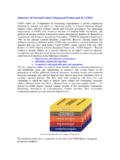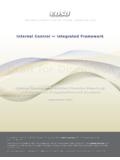Transcription of Internal Control COSO’s Updated Framework - …
1 Internal Control coso s Updated Framework A conversation with Institute of Internal Auditors San Diego Chapter January 8, 2014 PwC Agenda coso s Internal Control - integrated Framework (2013) Transitioning ICFR to 2013 Framework Slide 1 PwC What action has your organization taken in response to coso s 2013 Framework ? discussions with senior management and the Board on the potential impacts mapping existing ICFR to 2013 Framework mapping other systems of Internal Control to 2013 Framework mapping exercise(s) to 2013 Framework to perform assessment(s) next year not plan to take any action / Do not know Slide 2 PwC coso s Internal Control - integrated Framework (2013) Slide 3 PwC What is coso ? 1992 2006 2009 2013 2004 2010 Slide 4 Internal Control Publications Enterprise Risk Management and Other Publications PwC Why update 1992 Framework ?
2 Slide 5 Changes in the business environment Changes inside the business Lack of clarity 0%50%100% Control ActivitiesMonitoringControl EnvironmentInformation &..Risk AssessmentDifficult to interpretSomewhat difficult to interpretModerately easy to interpretDo stakeholders understand requirements of effective Internal Control ? Source - coso s survey of users and stakeholders, worldwide January to September 2011 Only 50% thought it was generally easy to interpret Lack of understanding PwC 2013 Framework preserves core strengths embedded in 1992 Framework What is NOT fundamentally Core definition of Internal Control Three categories of objectives and five components of Internal Control Each of the five components of Internal Control are required for effective Internal Control Important role of judgment in designing, implementing and conducting Internal Control , and in assessing its effectiveness Entity Structure Components Updated coso Cube Slide 6 PwC 2013 Framework increases ease of use coso s Internal Control integrated Framework (1992 Edition)
3 Consider changes in business & operating environments Articulate principles to facilitate effective Internal Control Expand operations and reporting objectives Update Context Clarify Requirements Broaden Application coso s Internal Control integrated Framework (2013 Edition) Refresh Objectives Updates Slide 7 PwC 2013 Framework articulates principles and points of focus 17 Principles Points of focus Controls 5 Components Points of focus describe important characteristics of principles Principles articulate fundamental concepts of components Components and Principles are requirements for an effective system of Internal Control Points of Focus and Controls are subject to management judgment Legend Slide 8 2013 coso Cube PwC 2013 Framework articulates seventeen principles for effective Internal Control Control Environment commitment to integrity and ethical values oversight responsibility structure.
4 Authority and responsibility commitment to competence accountability Risk Assessment suitable objectives and analyzes risk fraud risk and analyzes significant change Control Activities and develops Control activities 11. Selects and develops general controls over technology through policies and procedures Information & Communication relevant information internally externally Monitoring Activities ongoing and/or separate evaluations and communicates deficiencies PwC 2013 Framework clarifies requirements for an effective system of Internal Control Components are present and functioning if each relevant principles is determined to be present and functioning ( , no material weakness exists) Relevant principles are present and functioning if persuasive evidence exists that controls are selected, developed and deployed to effect them Components operate together when.
5 Components are present and functioning Internal Control deficiencies aggregated across components do not result in the determination that one or more material weakness exist An effective system of Internal Control requires: Each of the five components of Internal Control and relevant principles is present and functioning The five components are operating together in an integrated manner Slide 10 PwC 2013 Framework describes points of focus for each principle, , Principles Principle 1 Demonstrates Commitment to Principle 2 Exercises Oversight Responsibility Principle 3 Establishes Structures Authority,.. Points of Focus Component Control Environment Slide 11 Sets the tone at the top Establishes standards of conduct Evaluates adherence to standards of conduct Addresses deviations in a timely manner Establishes oversight responsibility Applies relevant expertise Operate independently Provides oversight for the system of Internal Control Considers all structures of the entity Establishes reporting lines Defines, assigns and limits authorities and responsibilities Principle 4 Demonstrates Commitment to Competence Establishes policies and practices Evaluates competence and addresses shortcomings Attracts, develops, and retains individuals Plans and prepares for succession PwC Points of focus describe important characteristics of the principles.
6 For Principles Principle 6 Specifies suitable objectives Principle 7 Identifies and analyzes risk Principle 8 Assesses fraud risk Principle 9 Identifies and analyzes significant change Points of Focus Complies with applicable accounting standards Considers materiality Reflects entity activities Includes entity, division, operating unit, and functions Analyzes Internal / external factors Involves appropriate level of management Estimates significance of risks identified Determines how to respond to risks Considers various types of fraud Assesses incentive and pressures Assesses opportunities Assesses attitudes and rationalizations Assesses changes in external environment Assesses changes in business model Assesses changes in leadership Component Risk Assessment Slide 12 PwC Transitioning ICFR to 2013 Framework Slide 13 PwC Transitioning ICFR to 2013 Framework coso decided to supersede the 1992 Framework at the end of the transition period ( , December 15, 2014) SEC staff plans to monitor the transition for issuers using the 1992 Framework to evaluate whether and if any staff or Commission actions become necessary or appropriate in the future.
7 However, at this time, I ll simply refer users of the coso Framework to the statements coso has made about their new Framework and their thoughts about transition. (Paul Beswick, Chief Accountant) The SEC staff indicated more recently that the longer issuers continue to use the 1992 Framework , the more likely they are to receive questions from the staff about whether the issuer s use of the 1992 Framework satisfies the SEC's requirement to use a suitable, recognized Framework , particularly after December 15, 2014 when coso will consider the 1992 Framework to have been superseded by the 2013 Framework . (Center for Audit Quality's SEC Regulations Committee) Slide 14 PwC Transitioning ICFR to 2013 Framework A 404 transition timeline Educate and Communicate Phase 1 Conduct Preliminary Assessment Phase 2 Complete Assessment & Develop Action Plan Phase 3 Execute Action Plan Phase 4 12/31/14 May 13 Q3 Q1 Q2 Q3 Q4 2014 2013 Q2 Slide 15 PwC A 404 transition plan (example) Slide 16 Four-phases Key Actions Phase 1: Educate and Communicate Review 2013 Framework and illustrative tools Conduct training appropriate for board/committee members, senior management, managers ,etc.
8 Develop understanding of where principles are relevant at the entity ( , corporate) and subunits (divisions, subsidiaries, operating units and functional levels) Phase 2: Conduct Preliminary Assessment Map 17 principles (considering points of focus) to entity level controls (ELCs) Consider whether differences in controls exist at subunits Identify any significant gaps in design or SOX documentation of controls ( , assess whether each component of Internal Control and principle is present ) Phase 3: Complete Assessment & Develop Action Plan Perform comprehensive assessment and assess the operating effectiveness of controls ( , assess whether each component of Internal Control and principle is functioning ) Assess severity of any Internal Control deficiencies Identify changes in controls or SOX documentation necessary to remediate deficiencies Phase 4.
9 Execute Action Plan Remediate Internal Control deficiencies of SOX documentation, as needed PwC Potential impact on ICFR Reactions and responses will differ depending on circumstances If 1992 Framework has been thoroughly applied to current ICFR, the transition should not result in significant changes or incremental effort Preliminary assessment ( , mapping principles, considering points of focus, to controls) may reveal gaps in design or documentation of some controls -Design Controls are not designed to demonstrate a principle is present -Documentation Controls associated with the principle exist, but they are not included in the SOX Internal Control documentation Focus on design of indirect entity level controls (ELCs) that affect the 14 principles associated with the softer components of Internal Control . Indirect ELCs have an important, but indirect, effect on the likelihood that a misstatement will be detected or prevented on a timely basis.
10 No impact expected on design of direct ELCs and transaction level controls ( , three way match, cash reconciliation) relating to Control Activities Slide 17 PwC Potential impact on ICFR ELCs operate throughout the entire organization and often have a pervasive impact on controls. For example, the design of an indirect ELC focused on assessing financial reporting risks can be conducted at the corporate level to assess risks relating to all components of the entity ( , subunit locations) or at individual components Determining whether a principle is present is a matter of management judgment. Assessing the design of ELCs include: -Component(s) of the entity covered by the Control being evaluated -Objective of the Control -Who performs the Control with necessary authority and competence -Frequency of the Control 's operation -Specific procedures that are performed to meet the stated objective, including any information used in the operation of the Control By taking a fresh look at the design of indirect ELCs, management may identify opportunities to re-design controls to enhance effectiveness or efficiency Slide 18 PwC Potential Impact on ICFR Evaluation of the three principles related to the Control Activities component should be focused on the process for selecting, developing and deploying Control activities rather than the detailed Control activities themselves.
